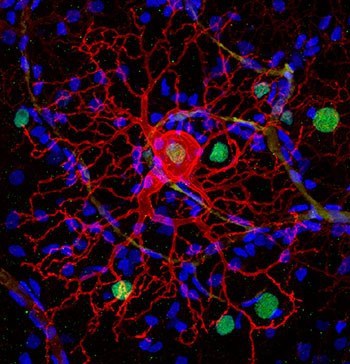For the millions of people around the world with inherited forms of blindness, the path toward a gradually dimming world may seem inexorable. But a new therapy that melds chemical and genetic approaches offers hope for restoring vision, even in patients whose world has gone dark. The treatment has already allowed once-blind mice to regain some vision, and shows promise in dogs, whose eyes share many similarities with those of humans.
William Beltran, an associate professor of ophthalmology, and Gustavo Aguirre, a professor of medical genetics and ophthalmology, both of Penn’s School of Veterinary Medicine, have worked for years to find treatments for various forms of inherited blindness. Up until now, some of the most effective strategies involve gene therapy, which requires first identifying the gene responsible in order to revive a patient’s photoreceptor cells. Thus, gene therapy is currently not an option for patients with forms of blindness for which the responsible gene mutation is unknown, or who have a disease so advanced that all their photoreceptor cells have degraded.
Working with John Flannery and Ehud Isacoff, two researchers from the University of California, Berkeley who developed the approach, Beltran, Aguirre, and colleagues used a viral vector to introduce a common ion channel into retinal cells known as ganglion cells, which are among the last to degenerate in blinding diseases, such as inherited retinal degenerations, and are not normally sensitive to light.
The team then delivered photoswitches—chemicals that change shape when hit with light—to the eye. These chemicals attach to the ion channels to make them open in response to light, activating the retinal cells and restoring light sensitivity.
The researchers report this week in the journal Proceedings of the National Academy of Sciences that this two-part strategy restored some vision to previously blind mice: The rodents were able to discern a flashing light from a still light. And, in dogs with an inherited form of blindness akin to the human disease retinitis pigmentosa, the treatment successfully imbued degenerated retinas with light sensitivity.
The real value of this approach, says Beltran, “is that even when there is no hope left for rescuing photoreceptors, there is still hope for some visual recovery.”
The Penn and Berkeley scientists are now working to optimize the photoswitch chemical and their delivery techniques to improve vision recovery. They hope to take these exciting findings from the mouse and dog models into human clinical trials in the next few years.
“A clinically relevant, large-animal model allows us to begin tackling the next challenges on the road to translating this novel therapeutic strategy to human patients,” Beltran says.


